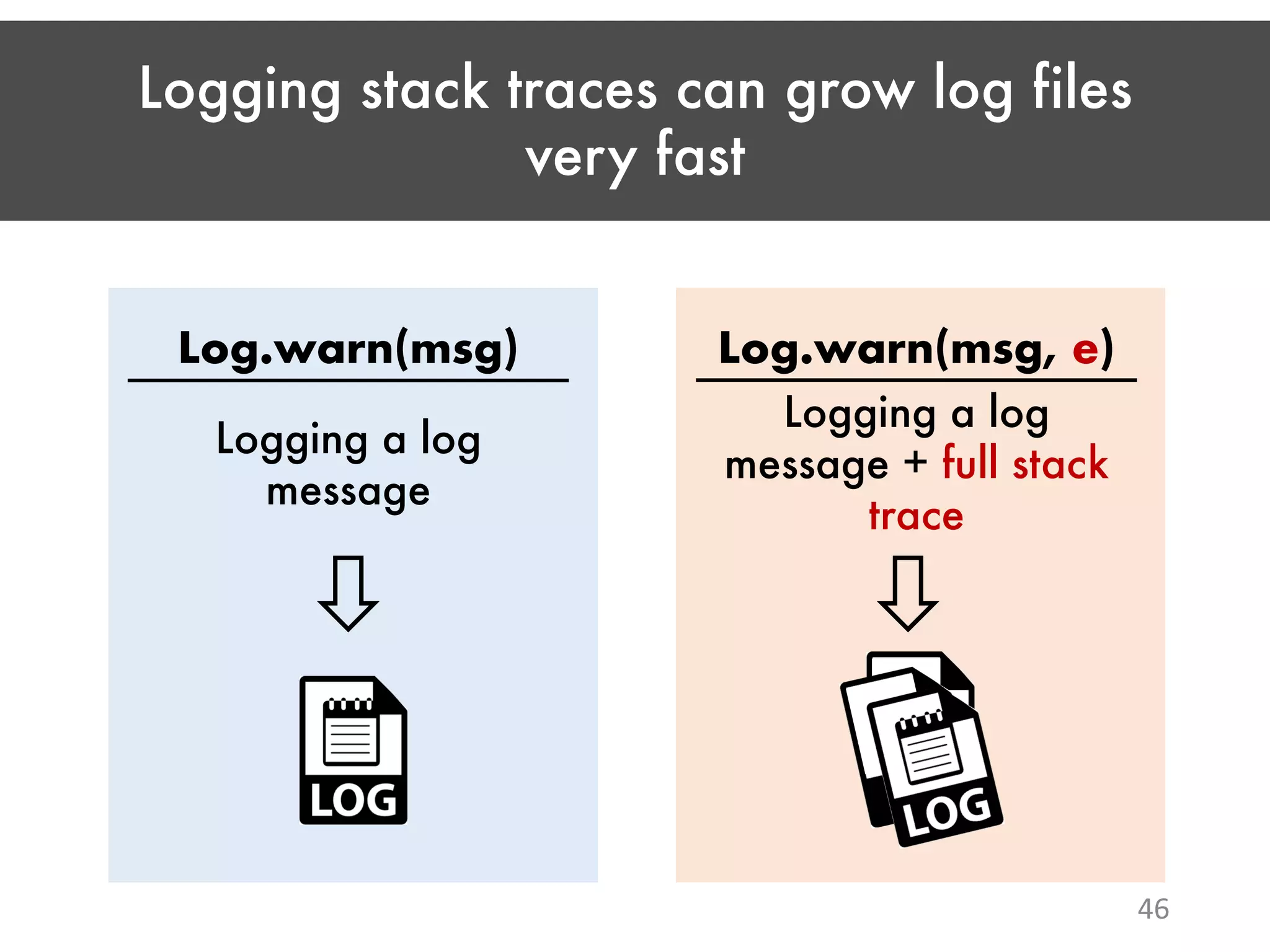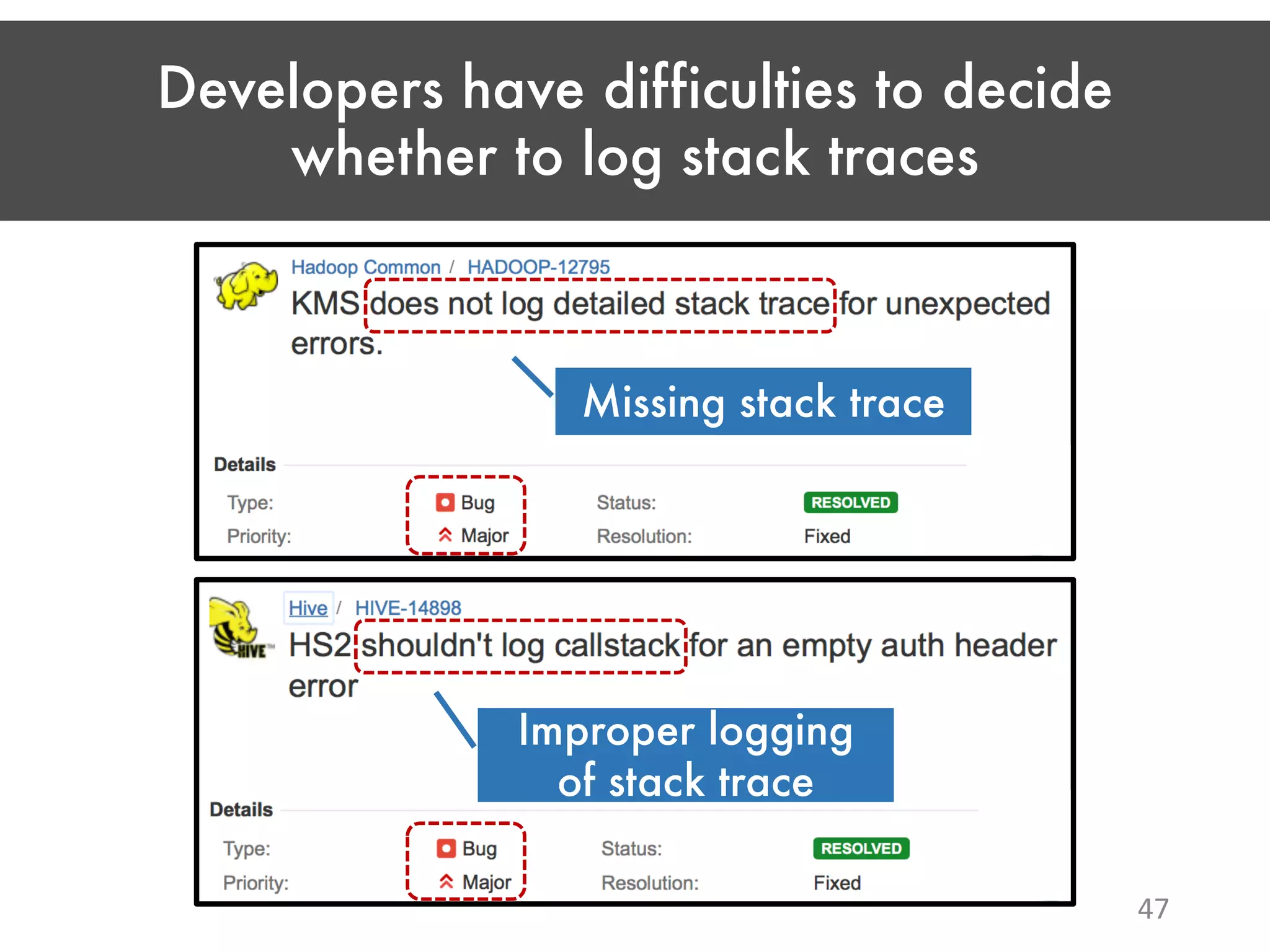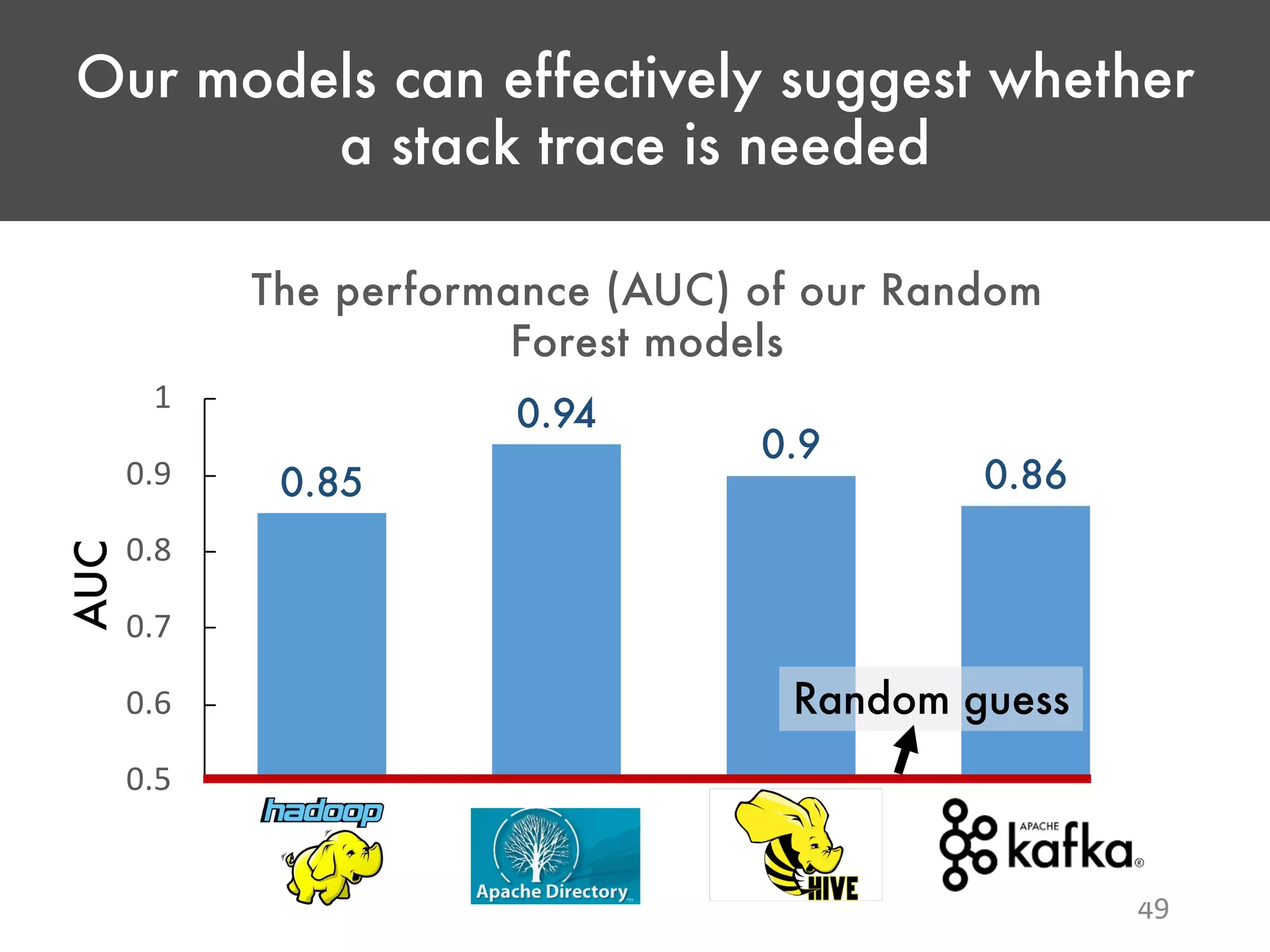This document summarizes Heng Li's PhD thesis on mining development knowledge to understand and support software logging practices. It discusses how logging code is used to record runtime information but can be difficult for developers to maintain. The thesis aims to understand current logging practices and develop tools by mining change history, source code, issue reports, and other development knowledge. It presents research that analyzes logging-related issues to identify developers' logging concerns, uses code topics and structure to predict where logging statements should be added, leverages code changes to suggest when logging code needs updating, and applies machine learning models to recommend appropriate log levels.
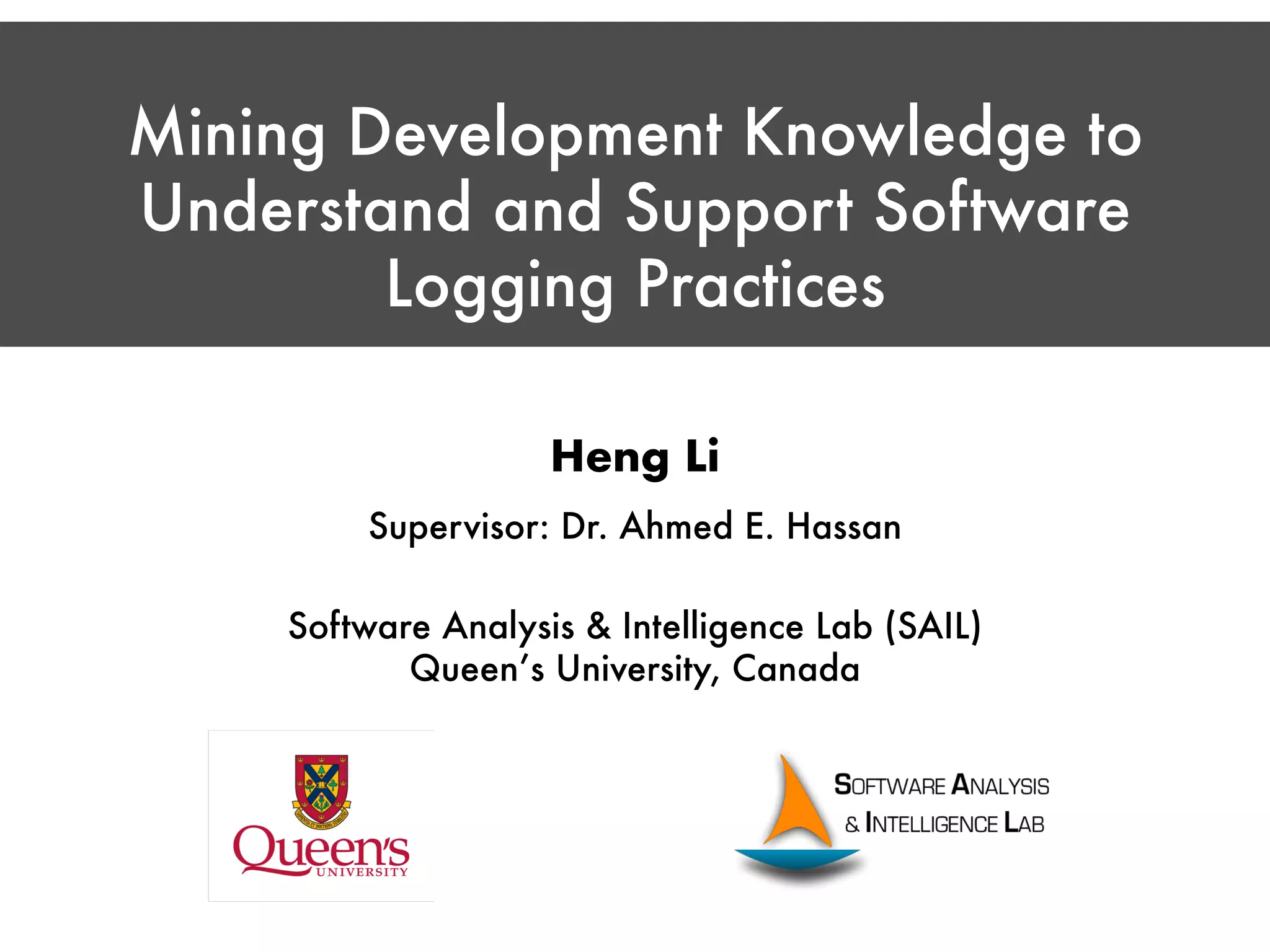
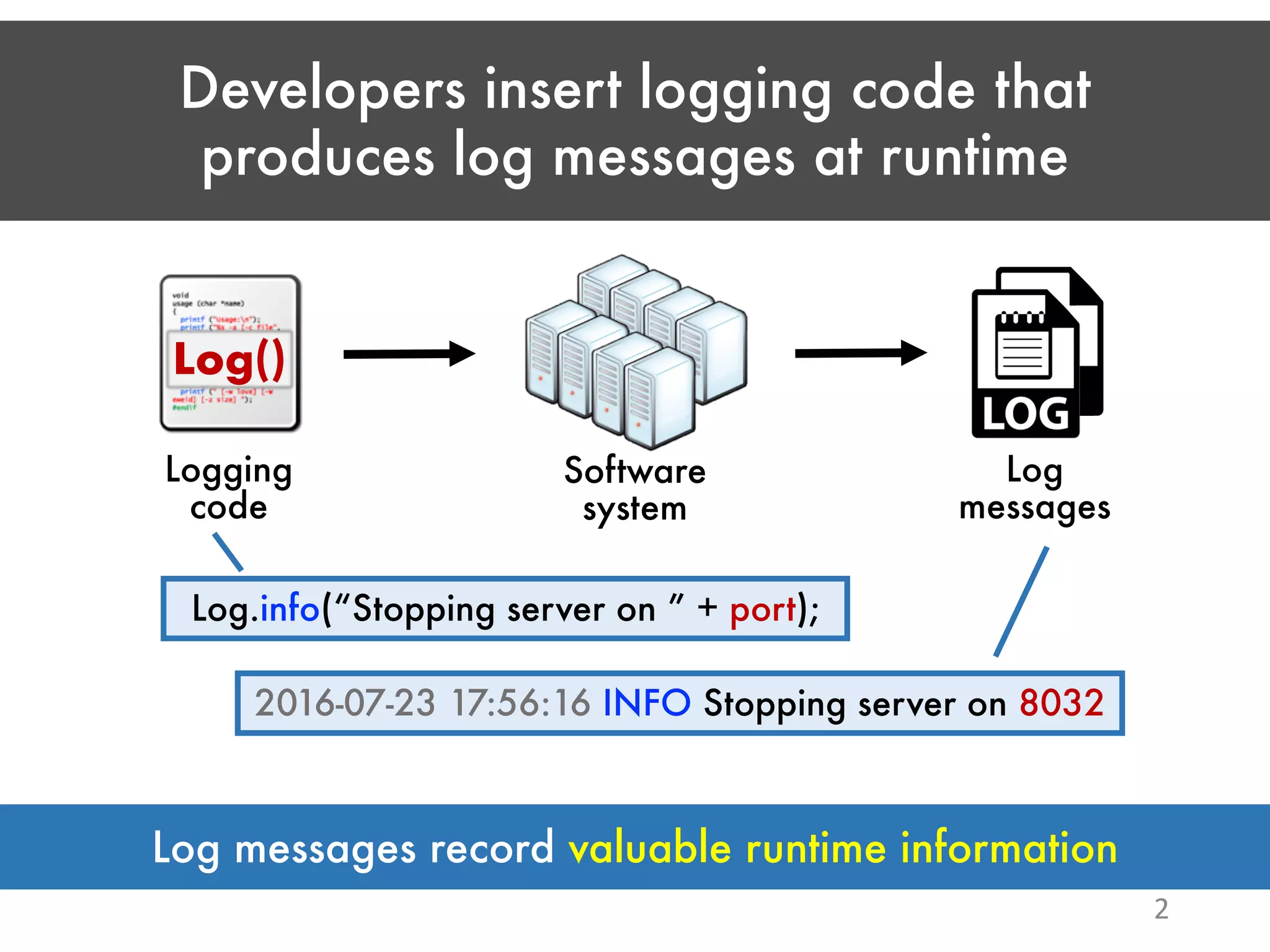

![Developers have difficulties deciding on appropriate logging code 4 “A lot of log noise” “Slowing down perf by 20%” “Missing an error log” Developers spend a significant amount of efforts maintaining their logging code § Logging practices in open source projects [Yuan et al., 2012; Chen and Jiang, 2017] § Logging practices in industry [Shang et al, 2014; Fu et al, 2014] Prior work](https://image.slidesharecdn.com/hengphdslidesv4-190320180057/75/Mining-Development-Knowledge-to-Understand-and-Support-Software-Logging-Practices-4-2048.jpg)

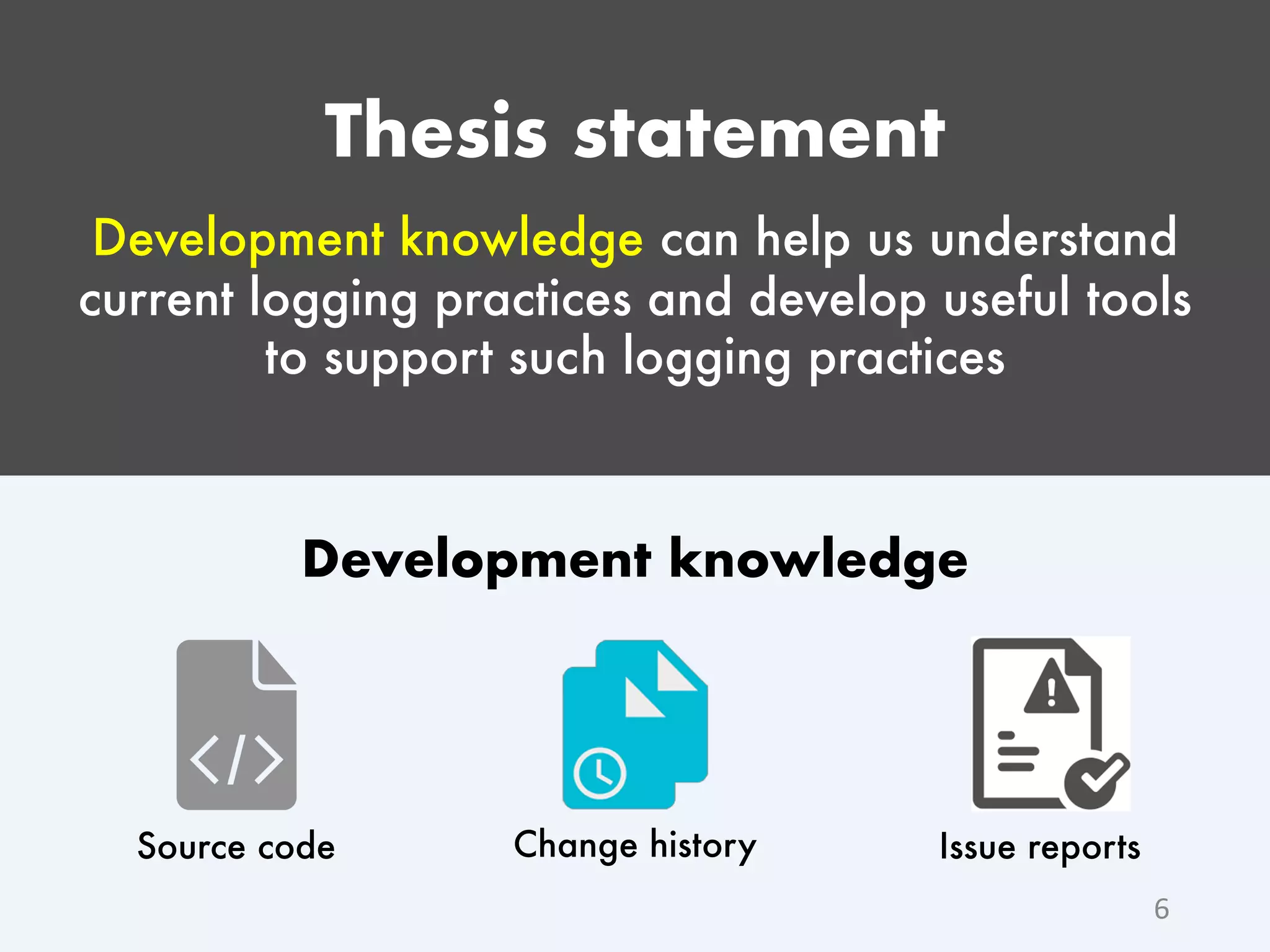
![Mining development knowledge to understand and support logging practices 7 Developers’ logging concerns? [TSE under review] Where to log? When to update log? How to log? [EMSE 2018] [EMSE 2017] [EMSE 2017] Error Warn Info](https://image.slidesharecdn.com/hengphdslidesv4-190320180057/75/Mining-Development-Knowledge-to-Understand-and-Support-Software-Logging-Practices-7-2048.jpg)
![Mining development knowledge to understand and support logging practices 8 Developers’ logging concerns? [TSE under review] Where to log? When to update log? How to log? [EMSE 2018] [EMSE 2017] [EMSE 2017] Error Warn Info](https://image.slidesharecdn.com/hengphdslidesv4-190320180057/75/Mining-Development-Knowledge-to-Understand-and-Support-Software-Logging-Practices-8-2048.jpg)

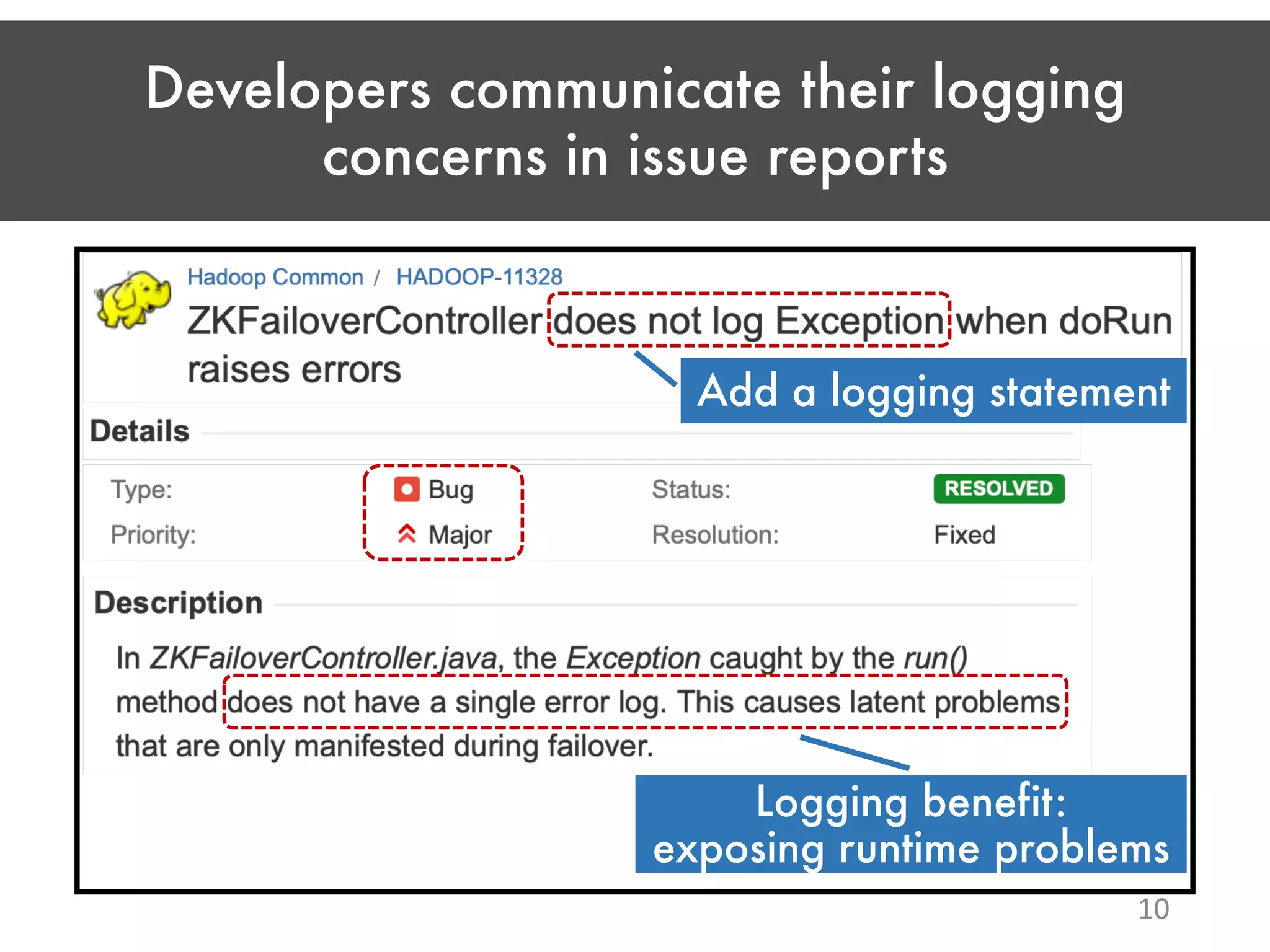
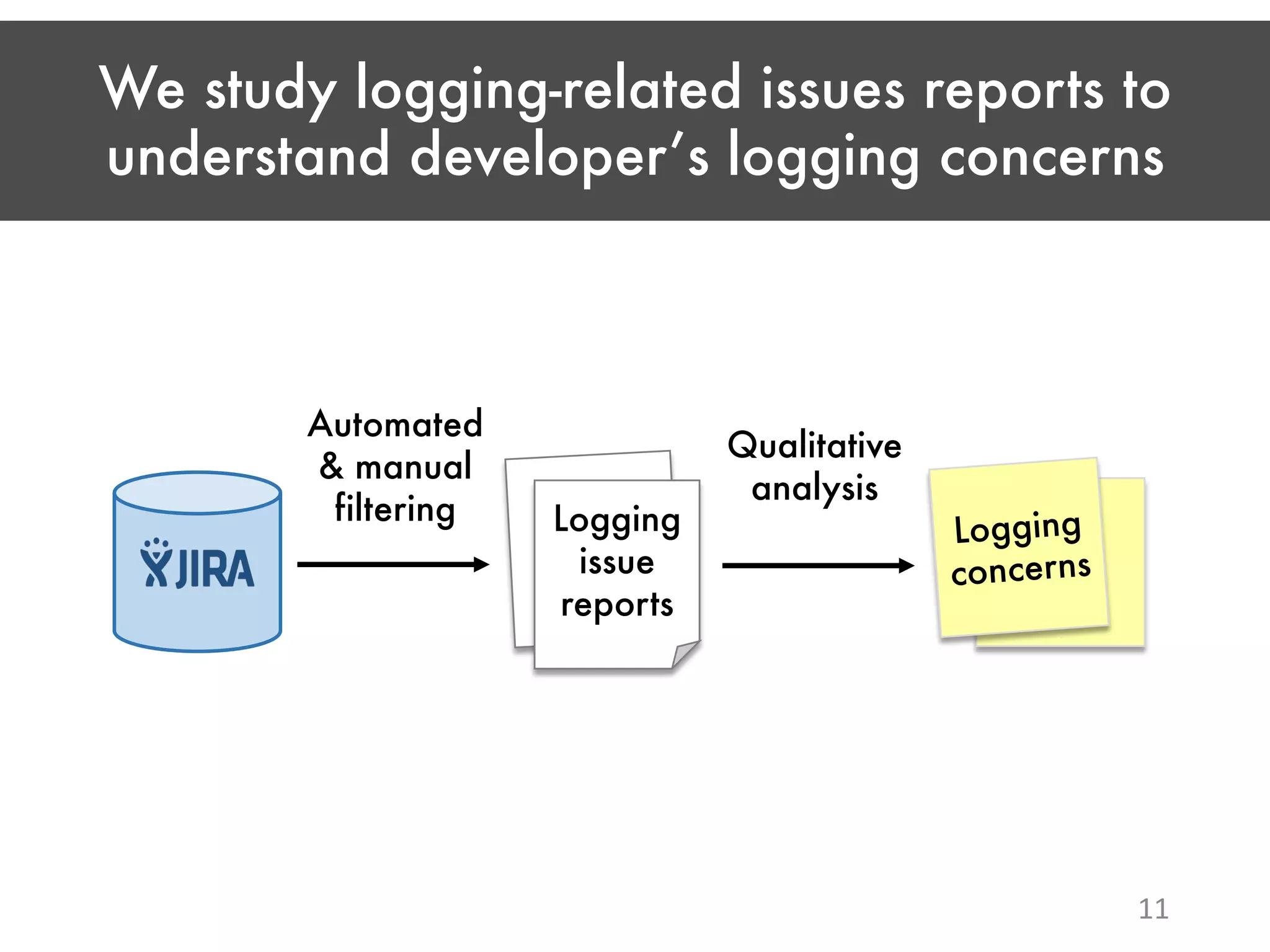
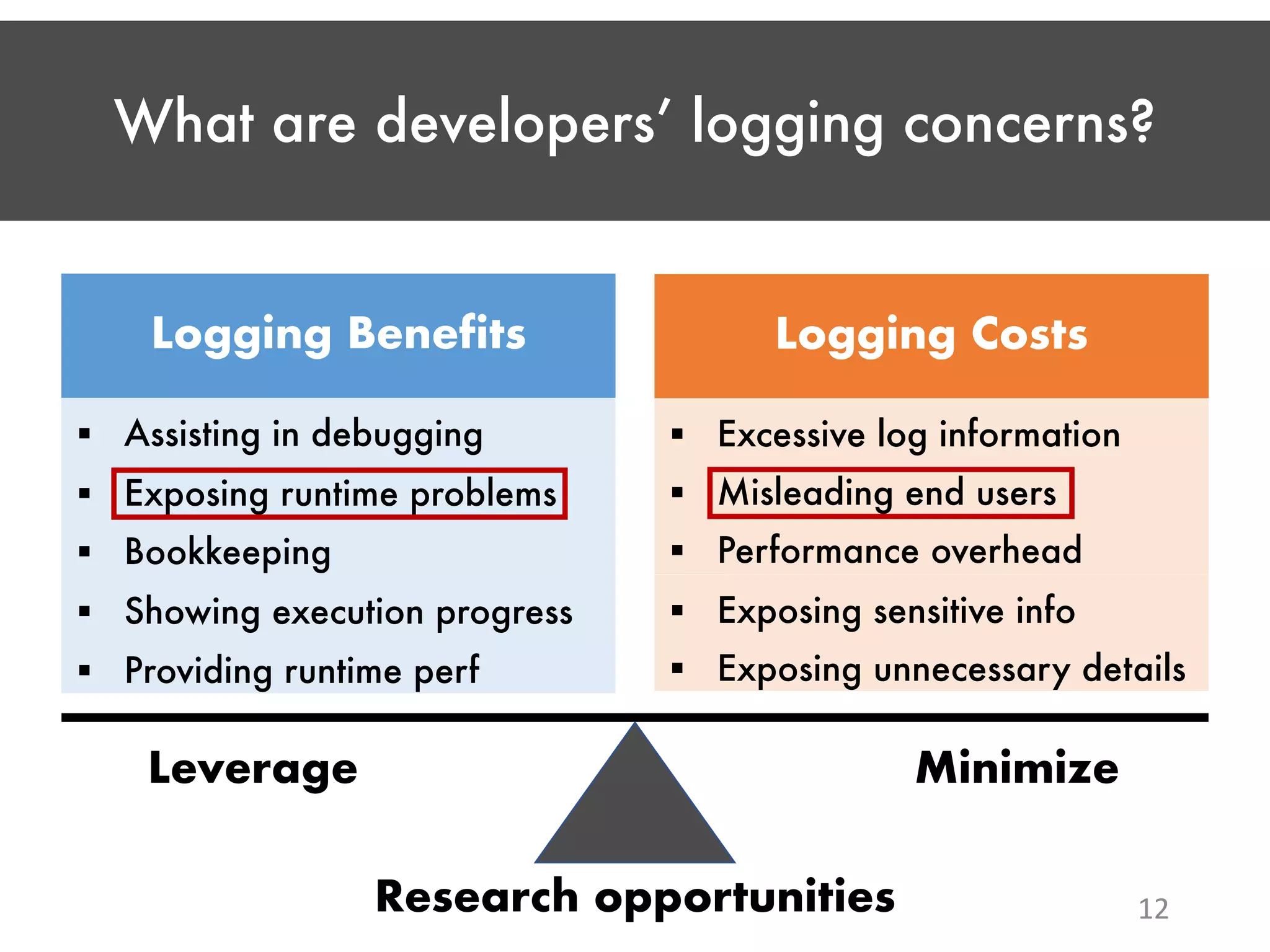
![Mining development knowledge to understand and support logging practices 13 Developers’ logging concerns? [TSE under review] Where to log? When to update log? How to log? [EMSE 2018] [EMSE 2017] [EMSE 2017] Error Warn Info 10 categories of logging concerns (e.g., misleading users)](https://image.slidesharecdn.com/hengphdslidesv4-190320180057/75/Mining-Development-Knowledge-to-Understand-and-Support-Software-Logging-Practices-13-2048.jpg)
![Mining development knowledge to understand and support logging practices 14 Developers’ logging concerns? [TSE under review] Where to log? When to update log? How to log? [EMSE 2018] [EMSE 2017] [EMSE 2017] Error Warn Info](https://image.slidesharecdn.com/hengphdslidesv4-190320180057/75/Mining-Development-Knowledge-to-Understand-and-Support-Software-Logging-Practices-14-2048.jpg)
![Some code topics are more likely to need logging statements 15 Examples of JIRA issues that require developers to log the topic of “connections” [EMSE 2018]](https://image.slidesharecdn.com/hengphdslidesv4-190320180057/75/Mining-Development-Knowledge-to-Understand-and-Support-Software-Logging-Practices-15-2048.jpg)
![Can code topics explain where to log? Topic: “connection” Logging statement [EMSE 2018] 16 We extract the code topics and logging statements for each code snippet (method level)](https://image.slidesharecdn.com/hengphdslidesv4-190320180057/75/Mining-Development-Knowledge-to-Understand-and-Support-Software-Logging-Practices-16-2048.jpg)
![We use LDA to extract code topics Logging statement [EMSE 2018] 17 Tokenization Topic model (LDA) queue, connection Topic: “connection”](https://image.slidesharecdn.com/hengphdslidesv4-190320180057/75/Mining-Development-Knowledge-to-Understand-and-Support-Software-Logging-Practices-17-2048.jpg)
![A small number of topics are much more likely to be logged Topic: “connection” Logging statement The most log-intensive topics usually capture communication between machines (e.g., ”connection”) or interactions between threads (e.g., “thread interruption”) [EMSE 2018] 18](https://image.slidesharecdn.com/hengphdslidesv4-190320180057/75/Mining-Development-Knowledge-to-Understand-and-Support-Software-Logging-Practices-18-2048.jpg)
![We combine both the structure and topic info to explain where to log Topic: “connection” Logging statement Structure info: lines of code, complexity, control flow statements, etc. [EMSE 2018] 19](https://image.slidesharecdn.com/hengphdslidesv4-190320180057/75/Mining-Development-Knowledge-to-Understand-and-Support-Software-Logging-Practices-19-2048.jpg)
![We combine both the structure and topic info to explain where to log Topic: “connection” Logging statement Structure info: lines of code, complexity, control flow statements, etc. LASSO model [EMSE 2018] 20](https://image.slidesharecdn.com/hengphdslidesv4-190320180057/75/Mining-Development-Knowledge-to-Understand-and-Support-Software-Logging-Practices-20-2048.jpg)
![Code topics bring additional explanatory power (up to 13% AUC improvement) 21 0.82 0.86 0.8 0.86 0.83 0.96 0.87 0.94 0.9 0.9 0.88 0.99 0.5 0.6 0.7 0.8 0.9 1 Structure info Structure & topic info AUC The performance (AUC) of our LASSO models Random guess [EMSE 2018]](https://image.slidesharecdn.com/hengphdslidesv4-190320180057/75/Mining-Development-Knowledge-to-Understand-and-Support-Software-Logging-Practices-21-2048.jpg)
![Mining development knowledge to understand and support logging practices 22 Developers’ logging concerns? [TSE under review] Where to log? When to update log? How to log? [EMSE 2018] [EMSE 2017] [EMSE 2017] Error Warn Info Logging varies across code topics](https://image.slidesharecdn.com/hengphdslidesv4-190320180057/75/Mining-Development-Knowledge-to-Understand-and-Support-Software-Logging-Practices-22-2048.jpg)
![Mining development knowledge to understand and support logging practices 23 Developers’ logging concerns? [TSE under review] Where to log? When to update log? How to log? [EMSE 2018] [EMSE 2017] [EMSE 2017] Error Warn Info](https://image.slidesharecdn.com/hengphdslidesv4-190320180057/75/Mining-Development-Knowledge-to-Understand-and-Support-Software-Logging-Practices-23-2048.jpg)
![Developers have difficulties to make appropriate log changes 24 Developers usually forget to change logging code when they change their code; in many cases, logging code is written as “after-thoughts” after a failure happens and logs are needed [Yuan et al., 2012] Commit n Commit n+1 Code changes Log changes Version k Debugging difficulties Code change history Maintenance efforts](https://image.slidesharecdn.com/hengphdslidesv4-190320180057/75/Mining-Development-Knowledge-to-Understand-and-Support-Software-Logging-Practices-24-2048.jpg)
![Learning from the code change history to provide log change suggestions 25 [EMSE 2017] Code Code Log Code Log ? Commit 1 Commit 2 Commit n… Code changes without log changes Code changes with log changes Do we need to change logs? Code change history](https://image.slidesharecdn.com/hengphdslidesv4-190320180057/75/Mining-Development-Knowledge-to-Understand-and-Support-Software-Logging-Practices-25-2048.jpg)
![LOG? Providing automated suggestions for log changes when developers change the code 26 Random Forest Classifier Log change suggestions Three dimensions 25 metrics Change metrics Historical metrics Product metrics [EMSE 2017] Code](https://image.slidesharecdn.com/hengphdslidesv4-190320180057/75/Mining-Development-Knowledge-to-Understand-and-Support-Software-Logging-Practices-26-2048.jpg)
![Our models can effectively suggest whether a log change is needed 27 0.84 0.91 0.86 0.88 0.5 0.6 0.7 0.8 0.9 1 AUC The performance (AUC) of our Random Forest models Random guess [EMSE 2017]](https://image.slidesharecdn.com/hengphdslidesv4-190320180057/75/Mining-Development-Knowledge-to-Understand-and-Support-Software-Logging-Practices-27-2048.jpg)
![LOG? The source code and code changes are important for explaining log changes 28 Log change suggestions Three dimensions 25 metrics Change metrics Historical metrics Product metrics [EMSE 2017] Code Explain](https://image.slidesharecdn.com/hengphdslidesv4-190320180057/75/Mining-Development-Knowledge-to-Understand-and-Support-Software-Logging-Practices-28-2048.jpg)
![Mining development knowledge to understand and support logging practices 29 Developers’ logging concerns? [TSE under review] Where to log? When to update log? How to log? [EMSE 2018] [EMSE 2017] [EMSE 2017] Error Warn Info The source code & code changes can explain log changes](https://image.slidesharecdn.com/hengphdslidesv4-190320180057/75/Mining-Development-Knowledge-to-Understand-and-Support-Software-Logging-Practices-29-2048.jpg)
![Mining development knowledge to understand and support logging practices 30 Developers’ logging concerns? [TSE under review] Where to log? When to update log? How to log? [EMSE 2018] [EMSE 2017] [EMSE 2017] Error Warn Info](https://image.slidesharecdn.com/hengphdslidesv4-190320180057/75/Mining-Development-Knowledge-to-Understand-and-Support-Software-Logging-Practices-30-2048.jpg)
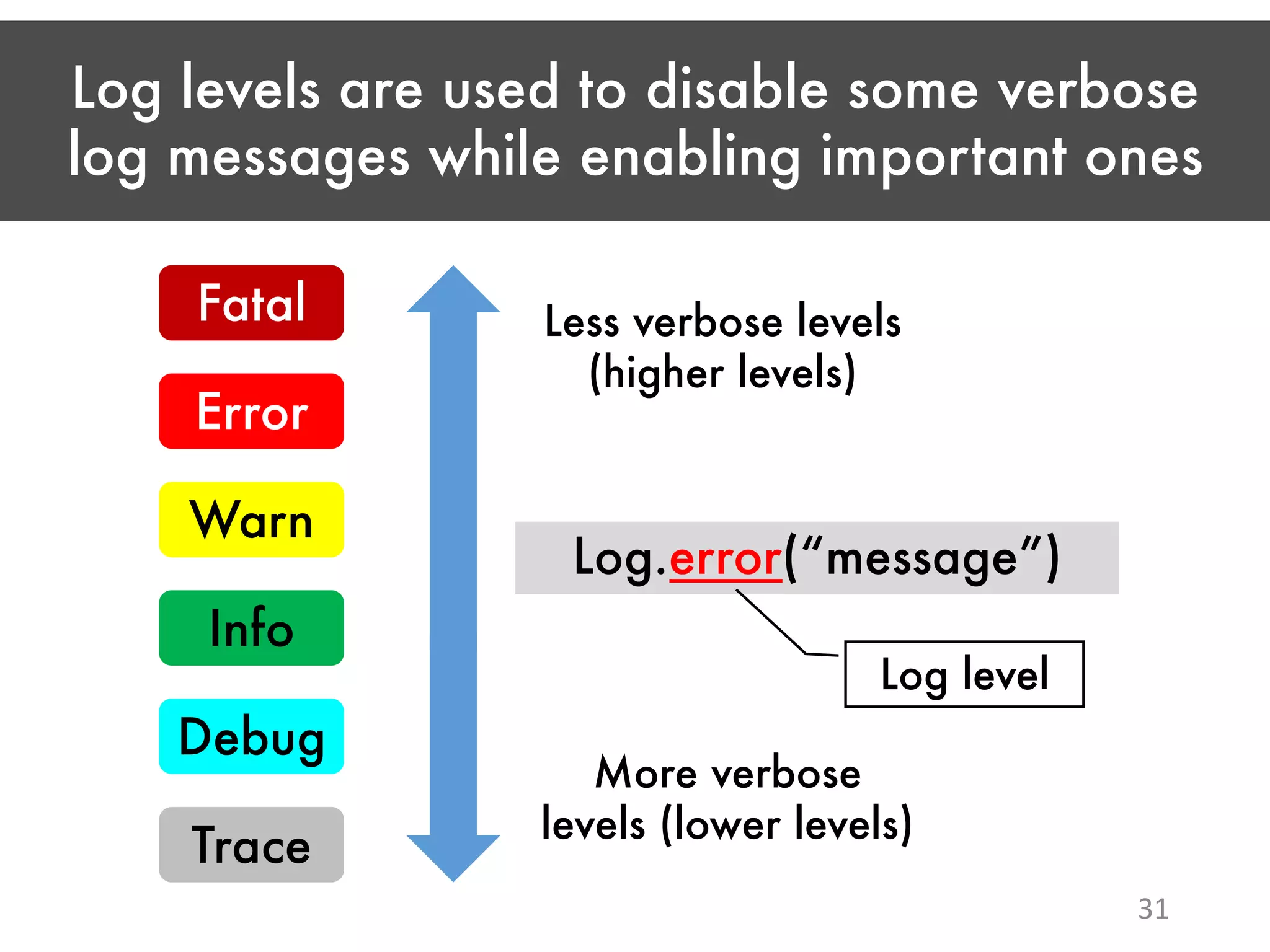
![Improper log levels can have many negative impacts 32 “…tends to generate a lot of log noise…” “These warnings worry users” Developers spend much efforts adjusting log levels [Yuan et al., 2012]](https://image.slidesharecdn.com/hengphdslidesv4-190320180057/75/Mining-Development-Knowledge-to-Understand-and-Support-Software-Logging-Practices-32-2048.jpg)
![Learning from the code change history to provide log level suggestions 33 [EMSE 2017] Commit 1 Commit 2 Commit n… Code change history Log.warn(msg) Log.info(msg) Log. ? (msg) Log.error(msg) Which log level to use?](https://image.slidesharecdn.com/hengphdslidesv4-190320180057/75/Mining-Development-Knowledge-to-Understand-and-Support-Software-Logging-Practices-33-2048.jpg)
![Providing automated suggestions for log levels when developers add logging code 34 Logging statement metrics Containing block metrics Containing file metrics Code change metrics Historical change metrics Trace Debug Info Warn Error Fatal Ordinal Regression Model [EMSE 2017]](https://image.slidesharecdn.com/hengphdslidesv4-190320180057/75/Mining-Development-Knowledge-to-Understand-and-Support-Software-Logging-Practices-34-2048.jpg)
![Ordinal regression models can effectively model log levels 35 0.76 0.78 0.81 0.75 0.5 0.6 0.7 0.8 0.9 The performance (AUC) of our Ordinal Regression Models AUC Random guess [EMSE 2017]](https://image.slidesharecdn.com/hengphdslidesv4-190320180057/75/Mining-Development-Knowledge-to-Understand-and-Support-Software-Logging-Practices-35-2048.jpg)
![The content of a logging statements and the containing block/file explain its log level 36 Logging statement metrics Containing block metrics Containing file metrics Code change metrics Historical change metrics Trace Debug Info Warn Error Fatal [EMSE 2017] Explain](https://image.slidesharecdn.com/hengphdslidesv4-190320180057/75/Mining-Development-Knowledge-to-Understand-and-Support-Software-Logging-Practices-36-2048.jpg)
![Mining development knowledge to understand and support logging practices 37 Developers’ logging concerns? [TSE under review] Where to log? When to update log? How to log? [EMSE 2018] [EMSE 2017] [EMSE 2017] Error Warn Info The log content & containing blocks/files can explain log levels](https://image.slidesharecdn.com/hengphdslidesv4-190320180057/75/Mining-Development-Knowledge-to-Understand-and-Support-Software-Logging-Practices-37-2048.jpg)
![Mining development knowledge to understand and support logging practices 38 Developers’ logging concerns? [TSE under review] Where to log? When to update log? How to log? [EMSE 2018] [EMSE 2017] [EMSE 2017] Logging varies across code topics Error Warn Info The source code & code changes can explain log changes The log content & containing blocks/files can explain log levels 10 categories of logging concerns (e.g., misleading users)](https://image.slidesharecdn.com/hengphdslidesv4-190320180057/75/Mining-Development-Knowledge-to-Understand-and-Support-Software-Logging-Practices-38-2048.jpg)


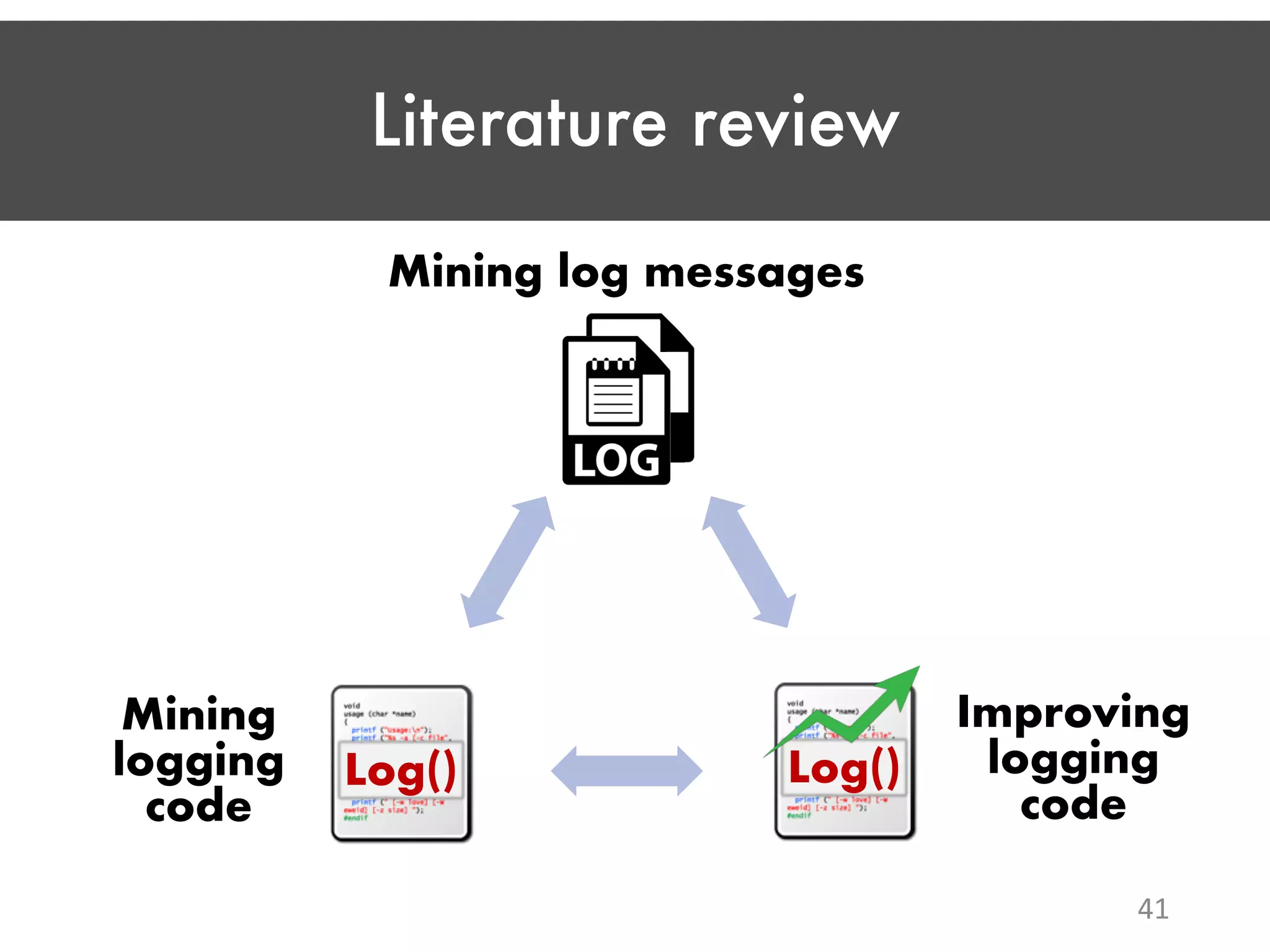
![Mining log messages 42 Understanding runtime behaviors [Fu et al., 2013; Hassan et al., 2008; Shang et al., 2013] Detecting anomaly conditions [Xu et al., 2008, 2009; Fu et al., 2009; Jiang et al., 2008] Diagnosing system failures [Yuan et al, 2010; Syer et al., 2013] Prior work highlights the importance of improving logging quality](https://image.slidesharecdn.com/hengphdslidesv4-190320180057/75/Mining-Development-Knowledge-to-Understand-and-Support-Software-Logging-Practices-42-2048.jpg)
![Mining logging code 43 Logging practices in open source projects [Yuan et al., 2012; Chen and Jiang, 2017] Logging practices in industry [Fu et al, 2014; Pecchia et al., 2015] Evolution of logging code [Shang et al, 2011; Kabinna et al., 2016] Log() Developers spend much effort maintaining their logging Software logging is a common practice](https://image.slidesharecdn.com/hengphdslidesv4-190320180057/75/Mining-Development-Knowledge-to-Understand-and-Support-Software-Logging-Practices-43-2048.jpg)
![Improving logging code: proactive logging 44 Proactively adding logging info in the source code [Yuan et al., 2011, 2012; Zhao et al., 2017] Log() Producing excessive log information Developers’ expertise and concerns are not considered](https://image.slidesharecdn.com/hengphdslidesv4-190320180057/75/Mining-Development-Knowledge-to-Understand-and-Support-Software-Logging-Practices-44-2048.jpg)
![Improving logging code: learning to log 45 Learning statistical models to suggest where to log [Zhu et al., 2015; Lal and Sureka, 2016; Jia et al., 2018] Ignoring logging patterns (e.g., log level, stack trace) Log() Focusing on one dim. of dev. knowledge (source code) Providing logging suggestions as a post-dev. process](https://image.slidesharecdn.com/hengphdslidesv4-190320180057/75/Mining-Development-Knowledge-to-Understand-and-Support-Software-Logging-Practices-45-2048.jpg)
